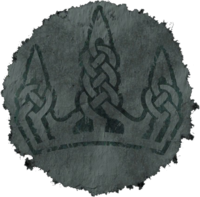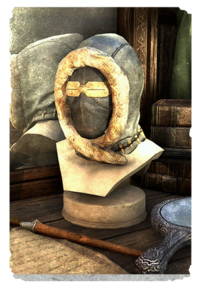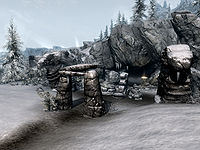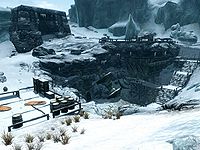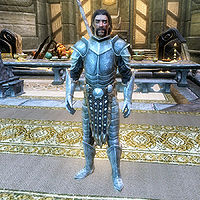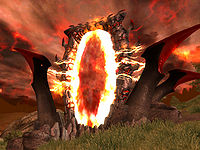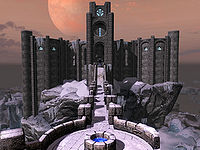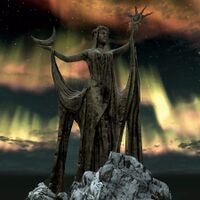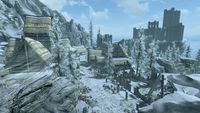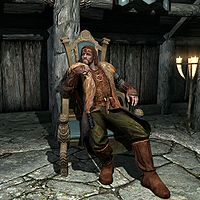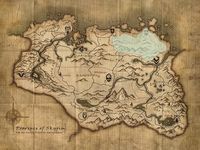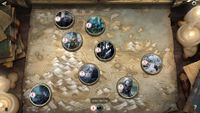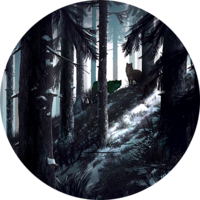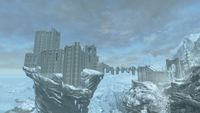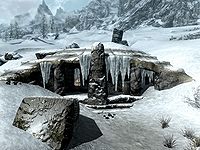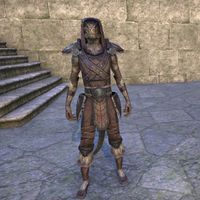Lore:Winterhold (region)
| Winterhold | |
|---|---|
| Type | Region |
| Continent | Tamriel |
| Province | Skyrim |
| Subregions | Broken Cape Ice Fields Mt. Anthor Range |
| Appears in | Skyrim, Legends |
Winterhold is a historical region located on the northeast coast of Skyrim, known for its inhospitable terrain and snow-blown landscape.[1] Centered around the city of the same name, it is one of the Old Holds of Skyrim, which are generally isolated by geography and choice.[2] The Nords of Winterhold are simple fisherfolk and mostly work on the Sea of Ghosts since there is little pasture for grazing and the cold winds prove brutal for livestock.[3] One of the region's most noteworthy landmarks is the College of Winterhold, the province's premier school of magic and center of both academia and arcana.[4]
When the province was part of the Third Empire, Winterhold was designated as a county and it was ruled by a King, much like its ancient rival, Solitude.[4][5] The capital city was also the seat of power for the entire province of Skyrim, but the exact timeline this occurred is unknown.[6][7] Winterhold is traditionally bordered by Eastmarch to the south and the Pale to the west.[8] Somewhere on the coast, the island of Olenveld is a day's sail away in the summer.[9]
Contents
Demographics and Ecosystem[edit]
Winterhold's population mostly consists of Nords just like any part of Skyrim,[10] but sources suggest that prior to Ysgramor's arrival in the late Merethic Era, proto-humans (alternatively known as Nedes) lived in the region because of a long-standing tradition of moving between Skyrim and Atmora. People that were specifically sent across were the malcontent, dissidents, rebels, and landless youth. The Saarthal region had passed hands over the course of years and its people only became stronger, engraving themselves in the area.[4][11]
Eventually, the Nords took over the Winterhold region and ancient ruins dotted the landscape, from the icy coast with Skytemple Ruins and Yngvild, to the snowcap mountains with Ironbind Barrow and Snow Veil Sanctum.[10] The people of the Old Holds stay true to ancient Atmoran tradition and outsiders can be a rarity. At the dead of winter, Nordic youth will travel to places such as Serpentstone Isle to kill an ice wraith and earn their citizenship.[2][12]
As some of the most northern parts of Skyrim, locals are more attuned to the elements and do not need shelters or dwellings as much. The wind is fundamental to Skyrim, and Nords that live in the far wastes "always carry a wind with them."[13]
Throughout the late Third Era and the early Fourth Era, Winterhold had a fluctuating Dunmer population, which was tied greatly to the historical events that played out. The first exodus came at the turn of the era and brought great prosperity to the county. The new population reinvigorated the capital city's ancient mercantile spirit and text preserved from the east was archived in the College of Winterhold.[4] When the Red Year occurred, those that already lived in the city left for their homeland to assist the relief effort[14] but at the same time, more refugees took their place in Winterhold. Eventually, a percentage of those refugees left Skyrim for Solstheim, but some of them stayed.[15]
At some point in time, the Dwemer moved into Skyrim, and by extension Winterhold as well. They originally came to the province sometime in the mid-early First Era after Clan Kragen first settled in the Reach and since then built cities of their own.[16] These cities were eventually abandoned and ruined across Skyrim. The largest ruin in Winterhold is called Alftand, which was built into an active glacier.[17] Its depths extended deep underground and into Blackreach, a subterranean realm that exists only in myth to the local populace. The only other ruin is the Temple of Xrib, located deep underground in a cave now known as the Sightless Pit.[10]
Winterhold is one of the most inhospitable regions in Skyrim, and perhaps across northern Tamriel, but even here are samples of flora and fauna. On the mainland, coniferous trees and snowberry bushes laden the snowscape, and mountain flowers are seldom seen across the mountains. Toward the coast, however, explorers can find vast samples of spiky grass but very little Nirnroot.[10] The elderly and children of Winterhold would travel down to the coast and collect seaweed all day, which was then dried for weeks.[3]
The region hosts typical creatures that live in colder climates, such as ice wolves, snow bears and snowy sabre cats on land, as well as horkers and slaughterfish on the coast. Some of the rarest creatures to exist in Winterhold include the ice wraiths and wispmothers.[10] The freezing waters of Winterhold can also contain rare, deep water fish such as the Angler, the Arctic Char, the Arctic Grayling, and the Cod.[18][19]
History[edit]
- For the history specific to the city, see the: History of Winterhold
Proto-Humans and the Migration[edit]
The Songs of the Return suggest that Ysgramor and the Atmorans sailed across the Sea of Ghosts to flee civil war from the north. Over the course of time, the proto-humans traveled south as a fail-safe to stow away the malcontent, rebels, and landless people.[11] The ancient Winterhold region in particular, around Saarthal, changed hands many times and only became stronger as time passed.[4] Ysgramor and his people landed on Hsaarik Head sometime in the late-Merethic Era and traveled southwest, where they built Saarthal.[2]
The proto-Nords, who claimed the land as their own ancestral territory, came into conflict with the Snow Elves who established a society of prosperity.[20] These events culminated into the Night of Tears and the destruction of Saarthal but the true motives of the attack have left scholars intrigued. The author of the Night of Tears, Dranor Seleth, believes that it was not for control of Skyrim or a simple war for territory, but an underlining factor that the ancient Nords wanted to keep buried away from the Snow Elves.[21] In any case, Ysgramor and his two sons, Yngol and Ylgar, were forced to flee back to Atmora. As it was stated in the Songs of the Return, Ysgramor looked back at the burning ruins of his city and wept tears of ebony. Yngol collected these tears and forged the Harbinger's signature weapon, Wuuthrad.[22]
Ysgramor and his sons returned to ancient Skyrim with the Five Hundred Companions, volunteer warriors that vowed to follow the Harbinger and destroy the elves. They landed on Hsaarik Head after the fateful Storm of Seperation, which took the lives of the Harakk and its captain, Yngol.[23] As Ysgramor was saddened by the loss of his son, a traditional Atmoran barrow-hill was dug on the banks of the White River, the easternmost edge of Winterhold[24][10] and Yngol's crew was put to rest.[24] It was not long after that Ysgramor came across Yngol's barrow and felt compelled to build a city nearby, so that he may look out to his son's resting place. That city would become Windhelm, and originally, the Harbinger wanted to build a great tomb underneath the city for himself after his death. He later decided on an isolated barrow off the coast of Winterhold, northeast of the eponymous capital city and facing the then still-green Atmora.[25]
Early History[edit]
When the city or the country was established is currently unknown, but according to myth, Arch-Mage Shalidor created the entire city with only a whispered spell.[26] By the early First Era, Winterhold was an established country ruled by a Jarl, and one of its earliest leaders was Hanse, the next in line to the throne after High King Borgas, who passed in 1E 369.[2][27] When the Moot did not pass, the War of Succession broke out across Skyrim and the holds vied for control of the throne for the next several years. As it raged across the kingdom, the dragon Numinex laid waste to the countryside; wiping villages, burning cities, and slaughtering Nords.[28]
The Jarl of Whiterun Hold, Olaf One-Eye, offered to slay the dragon and set forth to confront him at his roost, Mount Anthor, in southeast Winterhold. The details of this event have varied between different tellings but the general consensus was that Olaf used the thu'um to defeat the Dragon in an epic battle, but doubters, famously such as Svaknir, denounced it as lies. In doing so, Svaknir was severely punished and his verse detailing Olaf's deception was nigh destroyed.[28]
In any case, in his subsequent conquest of Skyrim, cities like Winterhold fell one by one[29] until in the end, Olaf became the High King of Skyrim in 1E 420.[2][28] Since then, Winterhold has continued its service as a hold under the King of Skyrim. In the early years of the Second Empire, at the time ruled by Emperor Kastav, the capital openly rebelled in 1E 2804. The Dragonguard were originally called to quell the situation, but the order's master refused. They garnered support from the grandmaster on the grounds that it violated their Oath of Allegiance. In their stead, an Akaviri that was rejected by the Dragonguard, Kalien, was sent to put it down himself, which subsequently led to the city's destruction. Even if he was unassociated with the Dragonguard, the situation severely damaged the faction's reputation with the Nords.[30] The rebellion ended swiftly and successfully when Reman II assumed the role of Emperor. It was his first notable achievement during his tenure.[31] Years later in 2E 184, Winterhold and nearby Eastmarch were terrorized by a rogue dragon named Grahkrindrog.[32]
Concurrent to the Second Empire's decline, the High King of Skyrim, Logrolf, was assassinated in 2E 431, and contention for the throne was established between the High King's daughter, Freydis, and the Jarl of Solitude, Svartr. The latter claimed that the former was an illegitimate heir to the throne and so a Moot was called to choose a proper successor. Even though the Crown of Verity chose Freydis, a partial Moot in Solitude chose Svartr. A schism was created between the Nords and two kingdoms were established between the east and west.[33] The east, which comprised of the Old Holds, including Winterhold followed Freydis, who ruled as High Queen from Windhelm. This kingdom was active for a hundred more years and when it was ruled by Jorunn the Skald-King, it became part of the Ebonheart Pact.[34]
The Jarl ruling Winterhold years before 2E 582 had a daughter named Hildrif.[35]
Winterhold in the Third Empire[edit]
In the early years of the Third Empire around 2E 864, Saarthal's ruins were located by Imperial archaeologists in the vicinity of Winterhold,[2] despite the fact that reports of the ruin's whereabouts were known by 2E 582.[36] Well into the War of the Red Diamond, Queen Potema Septim attained full support from northern Morrowind and all of Skyrim, which would include Winterhold.[37]
Sometime in the reign of Emperor Uriel Septim VI, his half-sister, Morihatha, had married Baron Ulfe Gersen of Winterhold, which greatly elevated her prestige among the Empire's nobility. By 3E 313, Morihatha had become her half-brother's staunchest ally and later inherited his position as Emperor in 3E 320. With her she brought along the Archmagister of Skyrim,[38] Welloc,[39] and re-instated him as the Imperial Battlemage of Tamriel, a role unseen since Tiber Septim's reign.[38]
Roughly around 3E 432, Dunmer refugees flocked to the city and brought about a renaissance of power and influence. With their help, the College of Winterhold was able to create the Ysmir Collective, which in turn brought scholars from all over Tamriel to the county. The library became a cornerstone of academic life in the college ever since.[4] It is unknown how Winterhold exactly fared in the Oblivion Crisis, but the Old Holds at large were laid waste by the daedra according to rumors in Cyrodiil.[40] The largest effect the crisis had was establishing a growing distrust between the Nords and mages, including the Dark Elves. In time, the Dunmer slowly left Winterhold and while another exodus of elves came in 4E 5 at the behest of the Jarl, those that already lived in the capital left for home.[15][14]
The Fourth Era and onward[edit]
The Red Year was a catastrophic event in Morrowind when Red Mountain erupted and left the province devastated. This brought about a second exodus of Dunmer to Skyrim, but those faithful to Azura received visions of the destruction ahead of time and were guided west before it could happen. As a sign of gratitude, they built a large statue of Azura in the mountains, northeast of Mount Anthor.[41]
The main migration was welcomed by the Jarl of Winterhold, who had a particular interest to those that could contribute to the College.[15] Years later, however, the High King of Skyrim relinquished Solstheim to the Dark Elves in 4E 16.[42] The Nords held a common belief that all of the elves and mages would leave for the island but when that did not happen, many were left unsatisfied.[15]
In 4E 122, a series of violent storms wracked Skyrim's coast throughout the year and Winterhold's capital was mostly swallowed to sea. The college was spared from any damage, which left the locals to speculate that the mages had something to do with it. Arch-Mage Deneth wrote to then Jarl of Winterhold, Valdimar. Providing his condolences and stating his case that the college was not involved. Despite his claims, the Jarl's council pushed to blame the college and gossip had spread that the mages were the culprits. The event has since been remembered as the Great Collapse,[15] and over seventy years later, Winterhold saw little progress and it was nigh a ghost town.[43]
After the death of High King Torygg, Skyrim was plunged into civil war, which pitted the eastern holds with the west. At the time, Winterhold was ruled by Jarl Korir and he allied with the Stormcloaks. The faction was helmed by Jarl Ulfric Stormcloak of Windhelm, who sparked the conflict after killing the High King. The garrison in Winterhold was overseen by Kai Wet-Pommel[44], and the stronghold Fort Kastav played a pivotal role in the region's allegiance in the war.[45] At that same time, the College of Winterhold conducted an excavation of Saarthal's ruins, and the mage Arniel Gane worked with the college to document their findings. A class from the college conducted on-the-field research throughout the ruins and eventually stumbled upon an artifact of unknown origins called the Eye of Magnus.[46]
The artifact was eventually brought to the college and their search for information later involved the Staff of Magnus. While an initiate went to locate the staff, the Thalmor agent, Ancano, tampered with the eye and created a power surge that killed the Arch-Mage and ransacked the hold's capital.[47] The college was quick to save the town and while the initiate went to retrieve the staff, the college kept Ancano at bay and the Master Wizard, Mirabelle Ervine died protecting the mages.[48][49] With the Staff of Magnus, the initiate was able to confront Ancano and defeat him before he could take it away. Even with the Thalmor agent dead, the Eye still posed an immense threat and in order to keep it safe, the Psijic Order appeared and took the eye away to their home, Artaeum.[50]
Known Rulers[edit]
- The First Era
- The Second Era
- The Third Era
- The Fourth Era
Notable Places[edit]
- Alftand
- A Dwarven ruin built partially atop an active glacier with an entrance to Blackreach
- College of Winterhold
- A famous school for the arcane arts in the city of Winterhold.
- Fortress of Ice
- An ancient fortress that served as the home of Arch-Mage Shalidor.
- Fort Kastav
- Winterhold's regional fort, strategically placed on the main road between Winterhold proper and the Pale
- Hsaarik Head
- At the extreme northern tip of Skyrim's Broken Cape, it is the place where tradition holds that Ysgramor's Five Hundred Companions made landfall
- Mount Anthor
- A mountain famous as the site of the battle between Olaf One-Eye and the dragon Numinex
- Pilgrim's Trench
- A large ship's graveyard west of Ysgramor's Tomb
- Saarthal
- An ancient Nordic city that was sacked in the Night of Tears, Saarthal is where the Eye of Magnus was found in the Fourth Era
- Shrine of Azura
- A grand shrine of Azura built by Dunmer refugees in the early Fourth Era
- Winterhold
- The eponymous city of the region, located on the coast and at the end of the main road
- Yngol Barrow
- An ancient Nordic ruin known as the burial ground of Ysgramor's son, Yngol
- Ysgramor's Tomb
- The burial site of Ysgramor found northwest of Winterhold facing Atmora across the Sea of Ghosts.
Gallery[edit]
See Also[edit]
Books[edit]
- Cheeses of Skyrim: Whiterun, Winterhold, Eastmarch by B. — Descriptions of the cheeses of Skyrim
References[edit]
- ^ The Holds of Skyrim
- ^ a b c d e f g Pocket Guide to the Empire, 1st Edition: Skyrim — Imperial Geographical Society, 2E 864
- ^ a b Cheeses of Skyrim: Whiterun, Winterhold, Eastmarch — B.
- ^ a b c d e f Pocket Guide to the Empire, 3rd Edition: The Throat of the World: Skyrim — Imperial Geographical Society, 3E 432
- ^ a b Winterhold location and rumors in Arena
- ^ Kraldar's dialogue in Skyrim
- ^ Map of Tamriel – The Elder Scrolls III: Morrowind
- ^ Map of Skyrim – The Elder Scrolls V: Skyrim
- ^ The Exodus — Waughin Jarth
- ^ a b c d e f Winterhold region in Skyrim
- ^ a b Frontier, Conquest — University of Gwylim Press, 3E 344
- ^ Galmar Stone-Fist's dialogue in Skyrim
- ^ Children of the Sky
- ^ a b Brelya Maryon's dialogue in Skyrim
- ^ a b c d e f g On the Great Collapse — Arch-Mage Deneth
- ^ Arkngthamz-Phng — Neramo
- ^ Alftand Glacial Face Tattoos description text in ESO
- ^ Fishing Mastery, v3 — Swims-In-Deep-Water
- ^ Fishing Mastery, v5 — Swims-In-Deep-Water
- ^ Gelebor's dialogue in Skyrim: Dawnguard
- ^ Night of Tears — Dranor Seleth
- ^ Songs of the Return, Volume 5
- ^ Songs of the Return, Vol 2
- ^ a b Yngol and the Sea-Ghosts
- ^ Songs of the Return, Vol 19
- ^ A Minor Maze
- ^ Korir's dialogue in Skyrim
- ^ a b c Olaf and the Dragon — Adonato Leotelli
- ^ King Olaf's Verse
- ^ Annals of the Dragonguard — Brother Annulus
- ^ Reman II: The Limits of Ambition — High King Emeric
- ^ Atlas of Dragons — Brother Mathnan
- ^ The Crown of Freydis — Taleon Mythmaker
- ^ Loremaster's Episode of ESO-RP ZOS Interview
- ^ a b Mad Thadrig's dialogue in ESO
- ^ Vole's dialogue in ESO: Elsweyr
- ^ Brief History of the Empire, v 2 — Stronach k'Thojj III
- ^ a b Brief History of the Empire, v 4 — Stronach k'Thojj III
- ^ Response to Bero's Speech — Malviser, Battlemage
- ^ Tamriel Gate Responses generic dialogue in Oblivion
- ^ Aranea Ienith's dialogue in Skyrim
- ^ Solstheim Lore loading screen text in Skyrim: Dragonborn
- ^ Winterhold (city) location in Skyrim
- ^ Winterhold Stormcloak court in Skyrim
- ^ Fort Kastav's role in the Civil War questline in Skyrim
- ^ Under Saarthal faction quest in Skyrim
- ^ Revealing the Unseen faction quest in Skyrim
- ^ Containment faction quest in Skyrim
- ^ The Staff of Magnus faction quest in Skyrim
- ^ The Eye of Magnus faction quest in Skyrim
- ^ The Ship of Ice — Kjalsdottir
- ^ Pocket Guide to the Empire, 3rd Edition: Other Lands — Imperial Geographical Society, 3E 432
Note: The following references are considered to be unofficial sources. They are included to round off this article and may not be authoritative or conclusive.
- ^ Ted Peterson's posts in The Blue Dawn
